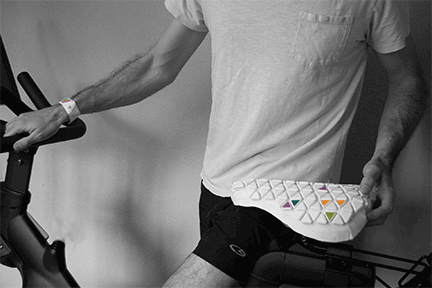Seeing Symbiosis
Visualizing Microbes Through Design

Seeing Symbiosis imagines new social interaction around sharing essential microbes in a healthy context. Today we are practicing social distancing to limit the exchange of harmful microbes, yet many benefit us. Visualizing our symbiotic relationships is a speculative strategy that prompts further research to investigate new ways of exchanging microbes, and the opposite of social distancing.
We can all smell body odor, but we can’t see it. Microbes change our bodies—like the bacteria that causes body odor—
but we’re not able to perceive the way our body’s microbiome is built and improved through sharing. Research today is showing many examples where an undesirable mix of microbes in the body can be replaced.
My project proposes a speculative design strategy to visualize and share these essential microbes around three main biomes: skin, mouth, and gut. This system uses everyday objects found in the home or gym, a networked watch, and
personal objects to reabsorb the microbes. The object surfaces are composed of smaller units, or chiclets, which can be shared between people, and change color in response to the microbiome absorbed within.


1. Through contact with skin and the environment, and accelerated by sweat, the seat cover absorbs microbiome, and broadcasts its health in color.


2. A networked device analyzes the color of the chiclets, and can inform our relationship with the microbiome samples, and the objects they live with.


3. This chiclet is indicated as beneficial, and reabsorbed into the body through a water bottle in this speculative design strategy.
Design can visualize something for science to work towards as microbiome research and materials science develop. As a strategy, this proposal abstracts something we find disgusting with each step—as microbes become color, are removed from the body, and placed in the watch, and traded. In this way, the chiclet takes the place of exchange rituals that would otherwise be too personal. More importantly, by broadcasting something invisible in a way we can perceive, the
microbiome becomes an icebreaker, and a way to show we need each other.
Not only could we use this system during a pandemic to identify contacts we need to avoid, we can use it during normal times to identify connections we need to make with each other because we are necessary to each others’ wellbeing.



